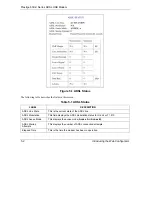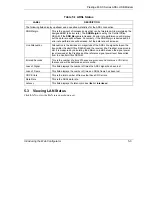
Prestige 630-C Series ADSL USB Modem
3-2
Installing Your Modem
REQUIRED INFORMATION:
FILL IN THE BLANKS
Framing Type
:
LLC
or
VCMUX
.
Modulation
: Your ISP will tell you which type of ADSL modulation it
uses. The default is
Automatic
.
Wiring Selection
: This is the type of wire being used for the
connection:
Line Tip/Ring
(default),
Line A/A1
, or
Automatic
.
User Name / Password
:
Lets your ISP know which account you are logging into and protects
your account from unauthorized users.
Vendor Name
:
The name of your vendor is also knows as the ADSL Head End.
ADSL Head End Env:
Your ISP will provide you with this information:
Non-Specific
or
No
Line Driver (BNA)
Your modem supports
RFC 1483
,
PPPoA
(Point to Point Protocol over ATM) and
PPPoE
(Point to Point
Protocol over Ethernet) drivers. These refer to the underlying data transport protocols. The RFC 1483 driver
works as an always-on account. The PPPoA and PPPoE drivers function as dial-up accounts.
When using the RFC 1483 driver, select the mode that your ISP uses, either
Bridged IP
or
Routed IP
.
The encapsulation type is also called multiplexing. Your modem supports both
LLC
and
VC/MUX
.
See the appendix for more information about VPI and VCI.
3.3 Installing the Web Configurator Driver
The following two sections describe how to install your and modem for both Mac OS 9 and X.
3.3.1 Mac OS 9 Installation
Step 1.
Close all Windows programs and applications.
Step 2.
Insert the included CD into the CD-ROM drive. An icon for the CD appears.
Step 3.
Double-click the CD’s icon.
Step 4.
Copy the driver
OS9 Package.sit
to a directory on your Mac and double-click it.
Step 5.
A folder named “
install USB ADSL
” will be created. Open this folder and double-click the
install
icon as shown next.
















































